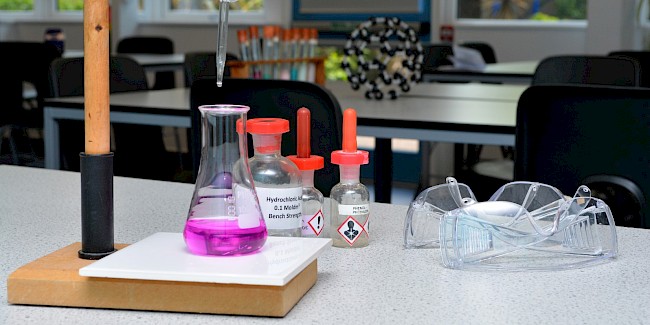Key Stage 4 Combined Science
Curriculum Overview
| | | Term 1 | Term 2 | Term 3 | Term 4 | Term 5 | Term 6 |
|---|
| Year 10 | Biology | Cell Biology | Organisation | Heath and disease | Plant Biology | Ecology | |
| Chemistry | Atomic structure and the periodic table | Structure, bonding and the properties of matter | The atmosphere | Sustainable development | Energy changes | Chemical quantities and calculations |
| Physics | Energy | Electricity | The particle model of matter | Atomic structure | Electromagnetism |
| Year 11 | Biology | Homeostasis and response | Inheritance, variation and evolution | Revision | |
| Chemistry | Chemical changes | Rates of chemical change | Hydrocarbons | Chemical analysis | Revision | |
| Physics | Forces | waves | Revision | |
Year 10 Biology
The year 10 Biology course focusses heavily on the structures and functions of living organisms. This includes the investigation of animals and plants with microscopes to compare different cell types. These ideas are then developed into an understanding of larger structures, organs and systems to provide a holistic set of concepts for animal and plant anatomy as well as the health and maintenance of these organisms. The ecology sections of year 10 will introduce practical field techniques and evaluate the positive and negative impact humans have had on the environment.
Year 11 Biology
In year 11, students will gain knowledge of the idea of homeostasis – the complex set of mechanisms that maintain a constant internal environment within our bodies. This will include ideas on; hormonal and nervous control of blood glucose, water, temperature and more. Towards the end of the course, students will be introduced to DNA, its structure and importance and will learn to critically evaluate the evidence behind the theory of evolution
Year 10 Chemistry
Students will explore the basic ideas of chemistry looking at the foundations of GCSE work of Atomic Structure and Bonding within the first 2 terms. After this the students will then consider some applications of the work by looking at the atmosphere and the sustainable development of the world around us through a chemical perspective. In terms 5 and terms 6 the basic ideas previously explored will then be dealt with in more detail where the ideas of energy and chemical calculations will then be explored. At the end of each topic knowledge is tested via an End of Topic test as well as mini assessments that will go on through the topic. These tests will be based around past paper questions about the topic, so students are introduced to exam technique, misconceptions and allows for time to fill in any gaps in knowledge. At the end of Yr 10 there will be an exam that will test all of the components studied that year.
Year 11 Chemistry
In Year 11 the students will study the final four components of the syllabus in preparation for their forthcoming exams in May and June. The first 2 components look at the aspect of chemical change as well as the kinetics involved in chemical reactions. They will then finish off by considering the chemistry of hydrocarbons and chemical analysis. In these topics, the ideas contained in the other topics are all brought together.
All of the topics taught in Yr 10 and Yr 11 will have examples of industrial contexts to ensure that the student understands how this relates to the world of work within the chemical industry.
Year 10 Physics
In year 10 students will learn what makes up the world around them. This will include fundamental concepts including; atomic structure and how this was discovered, the conservation of energy, radiation and its uses, how electricity and magnetism are linked and students will be introduced to the use of calculations to explain and predict physical effects in the real world.
Year 11 Physics
Physics in year 11 will develop the use of mathematics introduced in year 10. This will be applied to the unit of forces in which students will be able to describe the motion and behaviour of objects on Earth and in space. This combined with the work on waves and the electromagnetic spectrum will be heavily applied to situations that allow students to understand the reasons things in the physical world behave the way they do.
In each unit, regardless of the subject, students will experience a plethora of practical activities that will allow them to investigate, first hand, the science behind the theory they are learning.
Assessment
The Combined Science curriculum is wide and in depth. Students will be assessed in class frequently against exam style questions designed to habituate them to the challenges of their final exams. These questions will be structured in the form of small progress quizzes as students move through units culminating in more formal tests once a full unit has been completed.
There will be 6 formal exams at the end of year 11 (two for each subject). Each paper is equivalent to 16.7% of a student’s final grade and are structured as follows;
Biology paper 1 (topics 1-4) = Cells, Organisation, Infections and Bioenergetics.
Biology paper 2 (topics 5-7) = Homeostasis, Inheritance, Variation and evolution and Ecology.
Chemistry paper 1 (topics 1-5) = Atomic structure and the periodic table, Bonding and the structure of matter, Quantitative chemistry, Chemical changes and Energy changes.
Chemistry paper 2 (topics 6-10) = Rates of chemical change, Organic chemistry, Chemical analysis, The atmosphere and Using resources.
Physics paper 1 (topics 1-4) = Energy, Electricity, Particle model of matter and Atomic structure.
Physics paper 2 (topics 5-7) = Forces, Waves and Magnetism and electromagnetism.
Further reading/resources:
